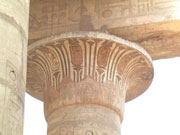TOUR NEWS - EGYPT FEBRUARY 2013
I arrived in Egypt on the 5th February, a few days before my group. Egypt had been on the news recently for the wrong reasons (riots around Tahrir Square in central Cairo) so it was a relief to see that the situation was settled and peaceful. I visited the Cairo Museum (largely empty in comparison to normal) and could see the protest tents in the distance. I also went to Saqqara with Bob Snow (also in Egypt a few days early) and we had a chance to see the newly reopened Serapeion, the catacombs of the mummified Apis bulls. The enormous granite sarcophagi were provided with rock cut chambers opening off an underground gallery � recent restoration of the Serapeion has been very impressive.
The Amarna Study Group left Australia on the 8th February, flying on Singapore Airlines with a brief stop in Singapore and Dubai. I met them at Cairo International in the early morning of the 9th February and they checked into their rooms at Mena House. The heart of the hotel is the mid-19th Century hunting lodge of the Khedive Ismail which has spectacular views to the pyramids � the views of Giza from the breakfast room are stunning.
Once everyone was settled in their room we took a short drive to Saqqara where we visited the ruins of Memphis and saw the colossal statue of Ramesses the Great in the local museum. We had a picnic lunch (falafel sandwiches) in a local caf� and then proceeded to Saqqara to see the remarkable Third Dynasty Step Pyramid of Djoser. We also explored the New Kingdom tombs of Maya (with its beautiful painted subterranean chambers) and Horemhab. Saqqara was very quiet with far fewer tourists than usual. We then went to see the newly opened Serapeion as a group.
 |
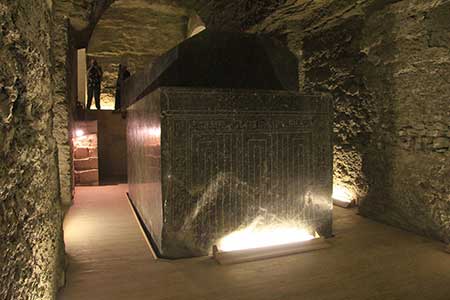 |
The group at Giza |
The Apis burials in the Serapeion |
The following morning we went to the Cairo Museum where we concentrated on the 18th Dynasty artefacts relating to our tour theme (the Amarna period during the 18th Dynasty when Akhenaten was king and introduced the cult of the sun god Aten). We concentrated on the statues and reliefs of the 18th Dynasty, the remains of the Amarna period, and the treasures of Tutankhamen. The Museum was very quiet with very few tourists in comparison to the usual crush (the lack of tourists is disastrous for businesses in Egypt with many hotels operating at minimal capacity). There was some free time in the afternoon for exploring other parts of the museum�s incredible collection. We then headed to the Bookshop of the American University in Cairo (Zamalek Branch) to browse through their extensive collection of books.
Monday 11th February was spent at Giza. We explored the area around the Great Pyramid (Steph saw even more of the site from the back of a camel) and we went to see the remarkable cedar boat of Khufu. We visited the nearby pyramid of Khafre and some of us went down into the burial chamber, a surreal experience! We also explored Khafre's impressive Valley Temple and saw the Sphinx close-up. Lunch was spent at the caf� in Al Azhar park (overlooking mediaeval Cairo) before heading off to the Khan el-Khalili markets. This mediaeval market is a maze of shops and old mosques famous around the world for its jewellery and metalwork. In the evening we stopped to have a coffee and cake at the Marriot Hotel (a late 19th Century Palace built for the Empress Eugene and the opening of the Suez Canal). We toasted Liz Anderson for her birthday.
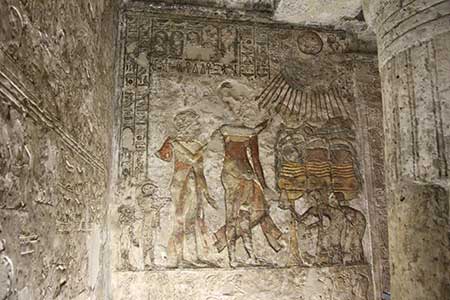 |
 |
The painted tombs at Amarna |
The Temple of Luxor |
On the 12th February we left Cairo and drove through the western desert to the Fayyum Oasis, a large depression fed by water from the Nile. Here we explored the extensive ruins of the Roman town of Karanis with two stone temples to the Crocodile god Sobek, ruined houses and baths. We had some coffee at King Farouq�s old hunting lodge at the edge of the Birket Qarun (Fayyum Lake) � this is now a hotel with beautiful view across the water. In the afternoon we stopped to see the pyramid of Senwosret II at Lahun before continuing south by bus to Minya. Here we checked into the Horus Hotel located beside the Nile � this was to be our base for the next 5 nights.
The following day we headed south of Minya to see a number of sites on the east bank of the Nile. The first stop was the Speos Artemidos, a desert temple of Queen Hatshepsut of the 18th Dynasty. Dedicated to the lioness goddess Pakhet ('She who scratches'), the shrine is located in a dramatic desert location. From here we went to Beni Hasan to see the beautiful tombs of the 11th and 12th Dynasties. The tombs are richly painted with scenes of daily life and there is a dramatic view from the plateau. We had a picnic lunch in the caf� at Beni Hasan before heading to see the ancient city and tombs of Hebenu, modern Kom el-Ahmar. A climb to the tomb of Nefer-sekheru offered a breath-taking view across the Nile Valley.
The 14th February was the first of our two days at the ancient city of Akhetaten, modern Amarna. We started by looking at the Royal Tomb, built to house the remains of King Akhenaten and his immediate family. The tomb is carved in an isolated desert valley east of the city. We then saw the impressive Boundary Stelae U, carved by Akhenaten to define the limits of his new city. After lunch in the local caf� we saw the marvellous North Tombs with their stunning view across the desert plain. The tombs are rich in detail of life at ancient Amarna. The following day we returned to the site to see the ruins of the North and Riverside Palaces and the houses in the North City. We also explored the ruins of the Central City including the temples to the Aten and the Royal Palace. The afternoon was spent in the South Tombs including the tomb of Ay. Thankfully in all the tombs we had unrestricted ability to photograph the wall scenes.
The following day we travelled south to the town of Malawi where we stopped to see the local Museum famed for its mummified ibises, sacred to Thoth the God of Writing'. We then visited the ancient site of Khmunu, modern Ashmunein. Here we saw the ruins of the temple of Thoth and the Christian Cathedral of the 5th Century. En route to Tuna el-Gebel we stopped to see Boundary Stela A of Akhenaten � someone had smashed the glass panels which protected the monument so we had an unobstructed view of the scenes (but I wonder how long it will stay unmolested). We had a picnic lunch before seeing the painted Ptolemaic tombs, including the famous Greek tomb of Petosiris, and explored the atmospheric underground galleries housing the mummified remains of the sacred ibises and baboons of Thoth.
On the 17th February we headed south on the desert road to Abydos. Here we explored the superb memorial temple of Sety I which preserves magnificent painted scenes from the Ramesside Period. We were the only tourists at the site and it was pleasant to spend time looking at and photographing all the scenes. We also saw the Osireion, a symbolic tomb for Osiris. After a late lunch we continued our journey south, arriving in Luxor in the early evening.
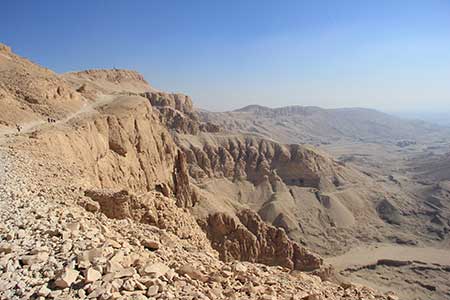 |
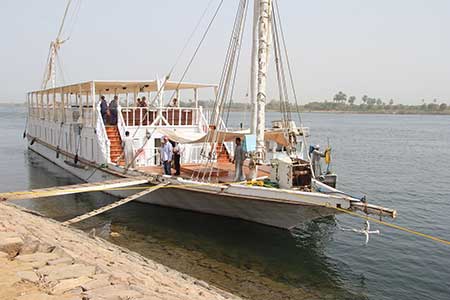 |
Walking the Theban Hills |
Our luxury dahabiya 'the Giraffe' |
The next morning we visited Luxor Temple, located in the heart of the modern city. We explored this picturesque monument concentrating on the impressive Opet Festival scenes of Tutankhamun and the religious scenes of Amenhotep III. Luxor was uncannily quiet with very few tourists at the monument. We had lunch in a nearby caf� with views over the temple. The afternoon was set aside for a rest � some members of the group went over to see some of the sites on the west bank.
The 19th February was set aside to explore the extensive ruins of Karnak Temple. This was perhaps the busiest site in Egypt with many package tourists coming up from the Red Sea. We saw the impressive Hypostyle Hall, the Third Pylon with its interesting Amarna period co-regency scene, and the 18th Dynasty Festival Hall of Tuthmosis III. We had a late lunch back in the hotel and then walked to the Luxor Museum to explore the numerous antiquities, including the famous temple scenes of Akhenaten.
The next morning we visited the colossi of Memnon, famous statues of Amenhotep which stood in front of his mortuary temple. We then went for a walk across the Theban Hills from Deir el Medina to Deir el-Bahri. The walk enabled us to look down in the Valley of the Kings and across the Nile Valley. We then explored the famous mortuary temple of Queen Hatshepsut. We had lunch in a local cafe before travelling by bus to the Valley of the Kings. We stopped to see the wonderfully restored House of Howard Carter (there are ghosts there I'm sure!) and then went to the Valley where we saw five royal tombs including the tomb of Tutankhamun in the main Valley and the tomb of King Ay in the West Valley.
On the 21st February we drove to Esna where we saw the well preserved remains of the Ptolemaic Temple of the Creator god Khnum, still partially buried in the town. The temple is being restored and the wall scenes are really stunning once the grime of centuries is removed. We joined our wonderful dahabiya (a two masted sailing boat with 9 ensuite cabins) called the Giraffe. This would be home for the next 5 nights � a very pleasant and relaxing way to sail up the Nile. After lunch we began our cruise. The boat is an original 1840 dahabiya with no on-board motor � we sailed when the wind was in our favour otherwise a small tug towed us on our way. A small generator on board provided electricity. It was pleasant to sit on the deck and watching the world go by. In the afternoon we dropped anchor near the ruins of El-Kab and had cocktails while the sun was setting over nearby islands.
The view across the Nile was magnificent in the early morning light. After breakfast we walked to the ruins of the ancient city of el Kab (Rachel and Steph took donkeys, much to the entertainment of us all). We stopped to see the temples of Nekhbet and Thoth and then walked over to see the superb painted tombs including those of Pahery and Ahmose son of Ebana. On our return we cast off and headed south towards Edfu � the afternoon was spent enjoying the local scenery and life on the river. We had cocktails as we watched the sun go down over the Nile and afterwards ate dinner on the deck of the boat. On the morning of the 23rd February we explored the wonderful Ptolemaic Temple of Horus at Edfu. We went to the temple by horse and carriage through the back streets of the city. Edfu has never been so quiet � for most of our visit we were the only tourists in the entire temple complex! The local merchants are having a very hard time due to the lack of customers and man y were too dejected to even ask us for business. On our return to the boat we were able to put the sails up and continue upstream. The river was generally very quiet with the number of cruise boats way down on normal � we did see a number of other dahabiyas however. The boat sailed through the narrow part of the river where the sandstone cliffs come down to the river�s edge � we anchored for the night beside the shrines of Gebel Silsila.
We explored the remarkable New Kingdom shrines at Gebel Silsila after breakfast the following morning. This included the Speos of King Horemhab (a rock cut temple of the late 18th Dynasty) and various shrines of the 18th Dynasty officials who quarried stone in this region. The cruise on our dahabiya sailboat then continued up the Nile. There was free time to relax, read and watch life on the river bank. In the afternoon we dropped anchor on a sandbank and went for a walk in the palm gardens. We then made our way to Kom Ombo where we took on some supplies before anchoring across the river for the night. That evening we enjoyed a hot cooked meal on the deck.
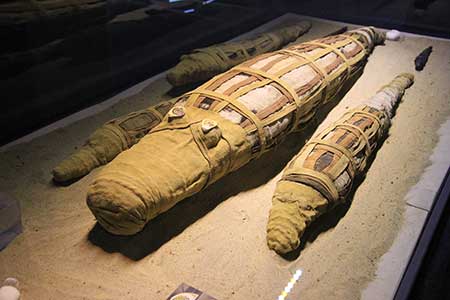 |
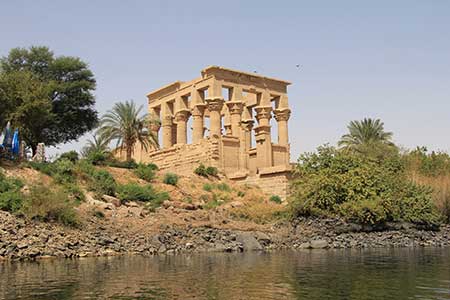 |
Crocodile mummies at Kom Ombo Temple |
Philae Temple |
On the 25th February we took the tug over the river to explore the ruins of the Ptolemaic temple of Sobek at Kom Ombo. Situated overlooking the river, the temple is a spectacular sight in the early morning and was greatly improved by having no other tourists � we were the only people there since the few cruise boats had moved on by the time we got to the site. We saw the newly opened Crocodile Museum which displays numerous mummified crocodiles and artefacts relating to the cult of Sobek � this is very well done! Our cruise then continued upstream towards Aswan. We enjoyed the life of the river and relaxing on the deck of our boat. Our cruise came to an end in Aswan where we anchored near the bridge. It was Janet's birthday so we had a cake and a party to celebrate the end of our voyage.
The following morning we left the boat and were driven into Aswan. We visited the temple of Isis on the island of Philae, one of the most beautiful temples in Egypt. The temple is approached by motor boat from the wharf near the Low Dam. We then saw the granite quarries and had some lunch by the Nile. There was some free time in Aswan to explore the local markets - these are suffering terribly from a lack of tourists. In the afternoon we stopped to see the Aswan High Dam before we flew to Cairo and checked into our hotel near the pyramids. Our last touring day was on the 27th February. We visited the Old City of Cairo to see the awe inspiring mediaeval buildings of the Islamic Period. Our first stop was the Citadel where we went to see the 14th Century mosque of Sultan el-Nasir Mohamed. We had an interesting talk with some local Muslim ladies who answered some of our questions about Islam (and tried to convert us!). We then saw the spectacular 19th Century Mosque of Mohamed Ali before heading to the old quarter of Cairo. We walked from the north walls of Cairo (Bab el-Futuh), stopping to see the restored Beit Sihaimi house from the Ottoman period. We had lunch and then free time in the Khan el-Khalili markets. As an end of tour treat we went to the Cairo Tower on Gezira for magnificent views over the city while the sun was setting; a fitting end to our tour dedicated to Akhenaten and his worship of the Aten.
Michael Birrell
